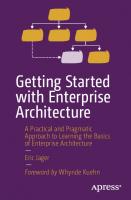Introduction to SparxSystems Enterprise Architect: Documenting Enterprise Architecture in the Most Affordable Enterprise Architecture Suite 9781484293119, 9781484293126, 1484293118
SparxSystems Enterprise Architect (EA) is a logical choice for many companies and organizations: it combines a broad fea
126 35 9MB
English Pages 255 [246]
Table of contents :
Table of Contents
About the Author
About the Technical Reviewer
Acknowledgments
Introduction
Chapter 1: Setting Up SparxSystems Enterprise Architect
Comparing the Different Versions of EA
Editions of EA
Flavors of EA
Downloading and Setting Up EA
Summary
Chapter 2: The First Model: Documenting the Systemplar Enterprise Architecture
Case 2-1: Documenting an Enterprise Architecture
Enterprise Architecture and the Zachman Framework
Notes on the Use of the Zachman Framework
Applying the Zachman Framework in Enterprise Architect
Repositories, Projects, and the Model Wizard
The Big Five of Enterprise Architect: Models, Elements, Diagrams, Connectors, and Packages
Models
Elements and Diagrams
Connectors
Delete the Connection Between Both Elements
Packages
Wrapping It All Up
Creating a Strategy Map in EA
The List of Geographic Locations
Summary
Chapter 3: Working with Elements
Elements
Elements Can Appear on Zero, One, or More Diagrams
Elements and Their Extended Properties
General Properties
Linked Documents
Responsibilities and Files
Related Elements
Adding Elements to the Model
The Visual Way
The Fastest Way
Flexibility Required? Try the csv Import!
Case 3-1: Importing a Project List into the Enterprise Architecture
Refining the Import with Parent-Child Relationships
Updating Instead of Importing
Finding Elements
Finding an Element from a Diagram in the Project Browser
Finding on Which Diagrams an Element Is Used
Finding Orphans
Deleting Elements
Bookmarking Elements
Element-Related Preferences
Element Default Appearance
Auto Names and Counters
Summary
Chapter 4: Connecting Elements with Connectors
Case 4-1: Relating Business Processes to Locations
Quickly Adding Links with the Quicklinker and Repeat Connector
Creating Links from the Project Browser
Relationship Properties
Connector Styles
Docking and Nesting Elements
Relationship-Related Preferences
Putting Elements on the Diagram Based on Links
More Options
Namespaces
The Traceability Window
Adding Information to Connectors: Notes and Information Flows
The Relationship Matrix
Saving Settings
Matrix Options
Exporting the Matrix
Working with Overlays
Summary
Chapter 5: Using Diagrams to Present Information
Case 5-1: A Business Process Model
Manual and Autolayout
Other Diagram Layout Options
Layout Tools
Manual Layouting
Copying Diagrams
Diagram Types
Status Colors
Legends
Case 5-2: A Heat Map for the Software Model
Step 1: Importing the Data
Step 2: Creating the Legends
Step 3: Using the Legends
Adding Elements to the Same Diagram Twice
Showing Alternative Info and Notes
Filtering Diagrams
Different Views: List, Gantt, Specification, and More
The Specification Manager
A List View
A Gantt Chart
Special Diagrams
Navigation Cells
Package Contents
Graphs
Saving Time Opening the Right Diagrams
User and Model Default
Working Sets
Save As a Shortcut
Importing Graphics
Diagram-Related Preferences
Summary
Chapter 6: Different Ways of Handling “Work to Do”
Bookmarking Elements
Adding #todo to Elements
Using Swimlanes to Get a Status Overview
Setting Up a Kanban Diagram
Case 6-1: A Kanban Diagram for the Enterprise Architecture
Setting Up the First Version
Adapting the Kanban Diagram
Adding and Removing Swimlanes
Tying the Item Status to the Phase Field
Defining Work in Progress Limits
Project Management in the EA Model
Summary
Chapter 7: Creating Reports and Slideshows
Diagram Exports
RTF Reports
Adding a Logo to the Footer
Changing the Color of the Main Title
Changing the Contents of the Report
CSV Exports
Exporting from List View
Exporting with an Export Specification
Exporting a Relationship Matrix
A Website
Case 7-1: A Website for the Enterprise Architecture
Slideshows in the EA User Interface
Summary
Chapter 8: Tagged Values and Stereotypes
General Types
Status
Constraint and Constraint Status
Difficulty
Priority
Test Status
Requirement
Scenario
Maintenance Status
Tagged Values
Adding a Tagged Value
Exporting Tagged Values
Applying to Multiple Items
Case 8-1: Adding Custom Information to the Enterprise Architecture Model
Local vs. Global Tagged Values
Dealing with Numeric Values
Additional Tagged Value Types
Stereotypes
Overriding Appearance with Metatypes
Overriding Appearance with Shape Script
A Simple Shape Script for Locations
Shape Main
Initializations
The Drawing Commands
The Text Command
Some More Connector Linked Shape Script Commands
An Example of a Shape Script Applied to Connectors
Shape Main
Shape Source and Target
Label Shapes
Summary
Chapter 9: Your Own Toolbox
Case 9-1: Leaving the Enterprise Architecture Model for the Architects of the Company
Exporting and Importing the Toolbox
Adding a Shape Script
Default Size
The Profile Helper
Inheriting Tagged Values
Adding Diagram Properties
Step 1: Adding the Diagram Property
Step 2: Changing the Shape Script of the Event Stereotype
Step 3: Updating the Existing Elements and Testing
Toolbox Visibility
Epilogue
Summary
Appendix: Useful Resources
Index
0.PNG
0.PNG
Table of Contents
About the Author
About the Technical Reviewer
Acknowledgments
Introduction
Chapter 1: Setting Up SparxSystems Enterprise Architect
Comparing the Different Versions of EA
Editions of EA
Flavors of EA
Downloading and Setting Up EA
Summary
Chapter 2: The First Model: Documenting the Systemplar Enterprise Architecture
Case 2-1: Documenting an Enterprise Architecture
Enterprise Architecture and the Zachman Framework
Notes on the Use of the Zachman Framework
Applying the Zachman Framework in Enterprise Architect
Repositories, Projects, and the Model Wizard
The Big Five of Enterprise Architect: Models, Elements, Diagrams, Connectors, and Packages
Models
Elements and Diagrams
Connectors
Delete the Connection Between Both Elements
Packages
Wrapping It All Up
Creating a Strategy Map in EA
The List of Geographic Locations
Summary
Chapter 3: Working with Elements
Elements
Elements Can Appear on Zero, One, or More Diagrams
Elements and Their Extended Properties
General Properties
Linked Documents
Responsibilities and Files
Related Elements
Adding Elements to the Model
The Visual Way
The Fastest Way
Flexibility Required? Try the csv Import!
Case 3-1: Importing a Project List into the Enterprise Architecture
Refining the Import with Parent-Child Relationships
Updating Instead of Importing
Finding Elements
Finding an Element from a Diagram in the Project Browser
Finding on Which Diagrams an Element Is Used
Finding Orphans
Deleting Elements
Bookmarking Elements
Element-Related Preferences
Element Default Appearance
Auto Names and Counters
Summary
Chapter 4: Connecting Elements with Connectors
Case 4-1: Relating Business Processes to Locations
Quickly Adding Links with the Quicklinker and Repeat Connector
Creating Links from the Project Browser
Relationship Properties
Connector Styles
Docking and Nesting Elements
Relationship-Related Preferences
Putting Elements on the Diagram Based on Links
More Options
Namespaces
The Traceability Window
Adding Information to Connectors: Notes and Information Flows
The Relationship Matrix
Saving Settings
Matrix Options
Exporting the Matrix
Working with Overlays
Summary
Chapter 5: Using Diagrams to Present Information
Case 5-1: A Business Process Model
Manual and Autolayout
Other Diagram Layout Options
Layout Tools
Manual Layouting
Copying Diagrams
Diagram Types
Status Colors
Legends
Case 5-2: A Heat Map for the Software Model
Step 1: Importing the Data
Step 2: Creating the Legends
Step 3: Using the Legends
Adding Elements to the Same Diagram Twice
Showing Alternative Info and Notes
Filtering Diagrams
Different Views: List, Gantt, Specification, and More
The Specification Manager
A List View
A Gantt Chart
Special Diagrams
Navigation Cells
Package Contents
Graphs
Saving Time Opening the Right Diagrams
User and Model Default
Working Sets
Save As a Shortcut
Importing Graphics
Diagram-Related Preferences
Summary
Chapter 6: Different Ways of Handling “Work to Do”
Bookmarking Elements
Adding #todo to Elements
Using Swimlanes to Get a Status Overview
Setting Up a Kanban Diagram
Case 6-1: A Kanban Diagram for the Enterprise Architecture
Setting Up the First Version
Adapting the Kanban Diagram
Adding and Removing Swimlanes
Tying the Item Status to the Phase Field
Defining Work in Progress Limits
Project Management in the EA Model
Summary
Chapter 7: Creating Reports and Slideshows
Diagram Exports
RTF Reports
Adding a Logo to the Footer
Changing the Color of the Main Title
Changing the Contents of the Report
CSV Exports
Exporting from List View
Exporting with an Export Specification
Exporting a Relationship Matrix
A Website
Case 7-1: A Website for the Enterprise Architecture
Slideshows in the EA User Interface
Summary
Chapter 8: Tagged Values and Stereotypes
General Types
Status
Constraint and Constraint Status
Difficulty
Priority
Test Status
Requirement
Scenario
Maintenance Status
Tagged Values
Adding a Tagged Value
Exporting Tagged Values
Applying to Multiple Items
Case 8-1: Adding Custom Information to the Enterprise Architecture Model
Local vs. Global Tagged Values
Dealing with Numeric Values
Additional Tagged Value Types
Stereotypes
Overriding Appearance with Metatypes
Overriding Appearance with Shape Script
A Simple Shape Script for Locations
Shape Main
Initializations
The Drawing Commands
The Text Command
Some More Connector Linked Shape Script Commands
An Example of a Shape Script Applied to Connectors
Shape Main
Shape Source and Target
Label Shapes
Summary
Chapter 9: Your Own Toolbox
Case 9-1: Leaving the Enterprise Architecture Model for the Architects of the Company
Exporting and Importing the Toolbox
Adding a Shape Script
Default Size
The Profile Helper
Inheriting Tagged Values
Adding Diagram Properties
Step 1: Adding the Diagram Property
Step 2: Changing the Shape Script of the Event Stereotype
Step 3: Updating the Existing Elements and Testing
Toolbox Visibility
Epilogue
Summary
Appendix: Useful Resources
Index
0.PNG
0.PNG

- Author / Uploaded
- Peter Doomen









